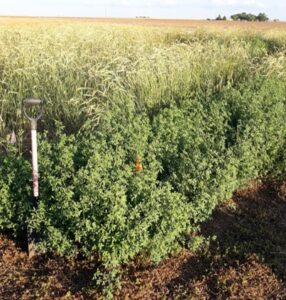Final report for OS19-131
Project Information
Adaptation and adoption of cover cropping practices has been extremely limited in semi-arid and arid western Texas. Potential exists for biological-fixed N to offset synthetic fertilizer inputs, and/or to produce high-quality forage for integrated animal systems. Research trials were coordinated on-farm (6 sites total) to assess warm- and cool-season legume species suitability for integration into existing crop rotations, as well as a warm-season legume demonstration at San Angelo. Warm-season cover crop species included mung bean, guar, sunn hemp, and three varieties of cowpea, with and without pearl millet. Cool-season cover crops included red clover, crimson clover, ‘Silver River’ sweet clover, arrowleaf clover, hairy vetch, and Austrian winter pea with and without cereal rye. On-farm warm season sites failed due to lack of rain in the late summer and fall of 2019, although the trial at San Angelo (spring planted) demonstrated Sunn hemp (4667 lbs ac-1) and cowpea (1839 lbs ac-1) as suitable warm-season legumes for the region. Cool-season trials highlighted hairy vetch, Austrian winter pea, and Silver River sweet clover as the best-suited winter legumes tested, with hairy vetch ultimately yielding similar to cereal rye. The legumes consistently exhibited superior forage nutritive value (high CP and low NDF) compared to rye, as well as lower C:N ratios. The cover crop practices tested in this project require further assessment, but demonstrate the potential to provide high-quality forages to supplement livestock production during critical periods, benefit the subsequent soil-crop interface, and enhance the resilience of overall farm systems.
- Assess the suitability of warm- and cool-season legume species and mixtures with corresponding grasses for integration into existing cotton and grain systems in West Central Texas.
- Quantify potential forage yield and nutritive value of cover crops to inform economic feasibility of integration.
- Measure cover/forage crop impact on subsequent crop nutrient uptake.
Cooperators
- (Educator)
- (Educator)
Research
A total of six research trials were coordinated across five farms in West Central Texas (Table 1). All warm season trials were planted in August following wheat harvest with the goal to take advantage of the long growing season and typical September and October precipitation. Two of three sites were no-till planted into wheat stubble, and one site was prepared with a light disk harrow. Cool-season trials were no-till planted behind either wheat or cotton in October and November (Table 1).
For all sites and systems, the experimental design was a randomized complete block design with four replications. Plots were 1.5 m wide by 9.1 m long (5 × 30 ft), planted with a small-plot no-till cone drill. Both warm- and cool-season cover crop treatments consisted of six legume species/varieties and a no-cover check, each with and without a grass (hybrid pearl millet in the summer and cereal rye in the winter) for a total of 14 treatments (Table 2). All legume seed was inoculated with the appropriate rhizobium per species and planted at recommended seeding rates (Table 2) to ensure adequate opportunity for stand establishment and N-fixing symbiosis. In mixtures, all legume and rye seeding rates were reduced to 75% of the recommended monoculture rate, and the millet seeding rate was reduced to 50% of the recommended rate (shown in Table 2). In addition to on-farm sites, a demo was planted at the Texas A&M AgriLife Research and Extension Center following grazed-out oats on May 10, 2019. The demo included large single plots of each warm-season legume species except guar (due to lack of appropriate inoculant at the time).
In each trial, soil samples were collected (0 to 15- and 15 to 30-cm) at the time of cover crop planting. Overhead pivot irrigation was available at one of the cool-season sites (Mereta), and plots were watered immediately after planting. All other sites were non-irrigated.
Emergence was extremely sparse and growth negligible at all three warm-season sites due to an uncharacteristic lack of fall precipitation (Figure 1). Consequently, there was no cover crop biomass or treatment differences to measure and these research sites were lost. The grower collaborator at the cool-season site near Lohn attempted calling and texting the wrong phone number (main Center office line) prior to terminating the trial, which was during the initial COVID-19 lock-down / quarantine of spring 2020, so this site was also lost. The warm season demo at San Angelo and the cool season trials at Mereta and Millersview resulted in ample biomass to sample, although the Millersview site was over-run by wild oat weed pressure and actual cover crop samples were not large enough for subsequent chemical analyses. Cover crop biomass was hand sampled from a representative 0.37 m2 (4 ft2) area per plot prior to termination. At the Mereta site, select treatments were sampled a second time prior to termination, as cover crops were allowed to grow longer at this site and interesting differences emerged. Samples were dried, weighed, ground, and analyzed via wet chemistry for total N content (informing crude protein (CP)), total C, and neutral detergent fiber (NDF). The Mereta site was the only successful trial that was also followed by the intended main crop, cotton. Cotton tissue samples were collected late in the season (9/29/2020) to measure any differences in nutrient uptake between the untreated check, rye cover crop, and hairy vetch cover crop.
All replicated measurements were analyzed using a mixed model procedure in SAS 9.4. If multiple locations of data were available (cool season biomass for example) then treatment and location were considered fixed effects and block(replication) nested within location was random. If only one location of data was available (chemical composition for example), then treatment was fixed and block was random. Box-Cox power transformations were applied when necessary to meet the criteria of normal distribution and homogeneity of variance. Transformed estimates were back-transformed for presentation. Differences were identified at α = 0.1 and means were separated using Fisher’s Protected LSD. Economic projections were also made regarding forage value and the possibility of livestock integration. Findings and observations from this project were presented at the 2020 Texas A&M Soils Critique, a large virtual agent training, and a large virtual grower workshop. Details on these outreach efforts are included in the corresponding sections below.

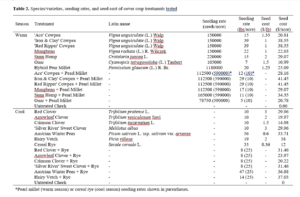
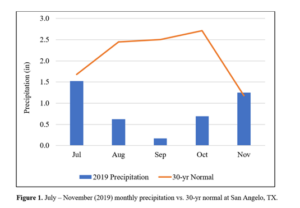
Warm-season Cover Crops
The warm-season trial at San Angelo demonstrated potential for pearl millet, sunn hemp, and cowpeas to be planted after grazed-out small grains in the spring (Figure 2), whereas failures at the other three sites exemplified risks and challenges associated with planting after a grain crop harvest. It is critical to be outside the window of any residual activity from previously applied herbicides, which restricted options, as all on-farm collaborators used Ally (metsulfuron-methyl) in their wheat. Late-season plantings are also highly dependent on timely fall precipitation, which did not occur in 2019. Opportunities to follow grain harvest with warm-season cover crops will continue to be explored. However findings from this project indicate that cool-season cover crops (or a mix of warm- and cool-season cover crops) may be a more suitable tool following grain harvest, and warm-season crops may be best suited to spring planting behind grazed-out or hayed winter forages.
Cool-season Cover Crops
Across sites, the rye seeding rate used for mixtures (25 lbs ac-1) proved to be too high, as legume establishment and growth was negligible or non-existent in the rye-legume treatments. This finding has guided ongoing and future on-farm research, as projects underway aim to identify optimum seeding rates for the region. Analyses in this project focused on comparisons of individual species/varieties, as the planted mixtures did not establish and function as mixtures (but only as rye). Winter cover crop species affected spring biomass at both sites sampled (P < 0.10)
At Millersview, rye, Austrian winter peas, and hairy vetch resulted in the greatest spring biomass (mean = 162 lbs ac-1) (Table 3), although wild oat biomass (mean = 1732 lbs ac-1) dominated the trial and essentially voided any benefit associated with the cost and effort to plant cover crops. Weed management in cover crop systems is a primary concern in this region and warrants future discussion and investigation. Successful integration of cover crops with low weed pressure may be challenging without the use of herbicides or tillage to start clean. Weed conditions may also be influenced by active grazing if weeds are desirable forage species, although this mechanism will likely select for increased occurrence of undesirable weed species.
At Mereta (irrigated), rye had greater biomass in April (5706 lbs ac-1) than all other crops, and hairy vetch biomass was greater than all other legumes (4216 lbs ac-1) (Table 3). Austrian winter peas followed, with greater biomass (2370 lbs ac-1) than crimson and arrowleaf clover (mean = 492 lbs ac-1). In May, rye and hairy vetch had the greatest biomass (mean = 7474 lbs ac-1) followed by Austrian winter peas and Silver River sweetclover (mean = 5290 lbs ac-1). Interesting relationships were observed among species regarding accumulation of growth between April and May. For example, the biomass increase from April to May was 22%, 90%, 132%, and 276% for rye, vetch, peas, and sweetclover, respectively. This helps inform timing of forage availability and optimum cover crop termination timing per species. Most of the rye growth had occurred prior to mid-April, whereas sweetclover growth increased greater than three times between mid-April and mid-May.
Differences in forage nutritive value also occurred among species (P < 0.10). Collectively all legumes had greater crude protein (CP) (mean = 22.4 %) than the rye (16.0 %) (Table 3). Austrian winter peas, crimson clover, Silver River sweetclover, and hairy vetch had the lowest concentrations of neutral detergent fiber (NDF) (40.2 %) compared to rye (58.6 %). NDF is bulk fiber (cellulose, hemicellulose, and lignin). Some roughage is important, and some of this fiber is digestible by ruminants, but greater NDF values generally indicate lower forage intake and overall reduced production efficiency.
Indicators of cover crop function (total tissue N and C:N ratio) also varied among species in both April and May (P < 0.10). Total tissue N is a function of total biomass and % N, and was closely correlated with the best-performing legumes (Table 3). Although rye consistently was among the greatest biomass, its lower N content resulted in the least total tissue N in May. Rye also consistently had the greatest C:N ratio, which is correlated with N content. C:N ratio is a critical indicator for the rate of organic residue decomposition and subsequent mineralization and availability of sequestered nutrients. In other words, a high-biomass cover crop with a high C:N ratio will result in very resilient residue and take longer to break down. Persistence of cover crop residue serves valuable roles for cover crop function (i.e. soil security, water infiltration, soil temperature regulation, and water retention), but also represents a “tied-up” nutrient pool. Findings from this research support that rye is an excellent cover crop for the physical functions of soil security and water retention, but these findings emphasize that it is both a lower-quality forage and slower to return nutrients to the soil than legumes.
This project found promising forage production potential, nutritive value, and cover crop function of legumes suitable for West Central Texas, particularly hairy vetch, Austrian winter peas, and Silver River sweetclover. Legume seed cost and timing of forage availability and/or cover crop termination will influence the optimum species for a given system. Hairy vetch was the best-performing legume, but also had the highest seed cost per acre. Silver River sweetclover did not accumulate as much winter growth, but exhibited rapid spring growth. Cover crops were terminated with glyphosate in this trial, but some tolerance was observed in both hairy vetch and Silver River sweetclover. Ability to terminate cover crops in a no-till system is an important consideration and may require careful attention and strategic herbicide use.
Cotton tissue nutrient concentrations were influenced by the preceding cover crop, including N, Mg, and Ca (P < 0.1) and a loose relationship/trend with K (P = 0.12). Cotton following hairy vetch had lower tissue N than cotton following rye, and tended to have lower tissue K than following rye and the untreated check (Table 4). Conversely, cotton following hairy vetch had higher tissue concentrations of Mg and Ca than cotton following rye or the untreated check. Tissue P, S, B, Zn, Mn, Fe, and Cu were not influenced by previous cover crop treatments (P > 0.1). The observed slight reductions in cotton tissue N and K may be explained by hairy vetch having the greatest aboveground biomass (and sequestered nutrients) at termination. This explanation may contradict assumptions that the lower C:N ratio of vetch means faster nutrient turnover, although faster mineralization and availability of nutrients does not necessarily mean “fast enough” for the current cash crop to use. Legumes are also recognized to exhibit an elevated K requirement and usage. Greater depletion of soil K by the hairy vetch helps explain the apparent increased availability of soil Mg and Ca subsequently measured in the cotton tissue, as availability of K, Mg, and Ca cations are interdependent and influenced by each other’s levels. These effects on cotton nutrient uptake emphasize that conventional assumptions about soil nutrient availability likely require modification in cover crop systems, and highlight need for soil analyses and corresponding fertility management relative to cover crops being used.
Educational & Outreach Activities
Participation Summary:
Findings from this project have been presented to producers via Extension programs and other stakeholder-oriented events, including the West Region Wheat Tour (48 attendees) and a Texas Farm Bureau Young Farmers & Ranchers tour (120 attendees). A virtual cover crop workshop was coordinated in place of in-person field tours (due to COVID-19), and had 51 attendees over an hour-long program with excellent feedback and discussion. At each of these events the project objectives and findings-to-date were discussed, followed by an open discussion / Q&A with attendees.
A virtual agent training was also coordinated to communicate findings to County Extension Agents (38 participants) serving agriculture and natural resources across the region, and this work was presented at the TAMU Department of Soil and Crop Sciences "Soils Critique" for discussion among faculty regarding implications and future direction of cover crop research in Texas.
In addition to organized outreach events, several conversations with grower collaborators and other interested growers resulted in 1-on-1educational opportunities. Updates and observations from these trials were also disseminated via Twitter with our agronomy program account (347 followers) A summary of the project and findings will also be published in an Extension publication in 2021.
Learning Outcomes
Project Outcomes
This project answered important questions regarding legume cover crop suitability and integration opportunities (as cover/forage crops) in West Central Texas crop rotations. Limitations were identified and expectations were adjusted relative to integration opportunities and common challenges. This work alone has not transformed farm management practices, but has initiated a conversation of interest and questions regarding strategic steps forward. Grower collaborators involved, as well as other participants of outreach programs, are invested in continued experiments and are excited to develop new and more sustainable systems.
Specific knowledge gains include insight to optimum species, as well as the timing of cover/forage crop integration relative to typical weather patterns and residual herbicide use. Recommendations and future work will build on sunn hemp and cowpeas as warm-season options, and hairy vetch, Austrian winter peas, and Silver River sweetclover as cool-season options. These species are now the subjects of ongoing on-farm research to identify the most cost-efficient seeding rates in this environment. As another product of this work, the warm-season legume focus has shifted to follow grazed-out or hayed winter forages (April/May planting) rather than behind a grain crop harvest.
Once implemented, sustained integration of legume cover crops has potential to reduce synthetic fertilizer inputs, as demonstrated by the total tissue N in legumes vs. rye in this research. The forage produced also represents potential to diversify economic value streams beyond one or two primary cash crops. Using a common projected value of $0.01/lb for standing forage in a grazing lease, a field of forage may be seasonally leased for up to $80/ac (maximum) or converted to 100 to 400 lbs/ac of animal gain assuming 50% grazing efficiency and a 10 to 1 conversion of forage to livestock gain. Despite the exciting gross potential, several factors need to be addressed as integration is considered. Many growers in this region also manage livestock, but many currently do not. Many fields are not fenced, and do not have a water source for livestock installed. These are relatively minor infrastructure requirements to achieve on the scale of sustainability and landscape change, but may inhibit or slow near-term integration.
Overall, the findings of this project provide a valuable starting point to develop functional integrated systems. With continued development and producer engagement, these concepts do have the potential to sustainably diversify and strengthen local economies and agricultural communities.
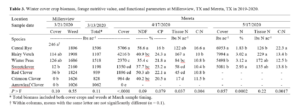

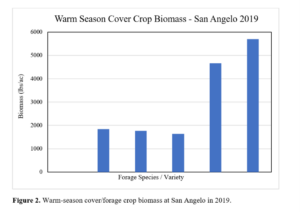
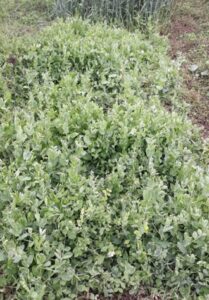
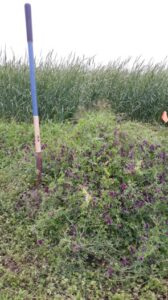
Silver River Sweet Clover in Mid-May
We appreciate the support and are excited about ongoing and future research efforts in this area. Thank you.
